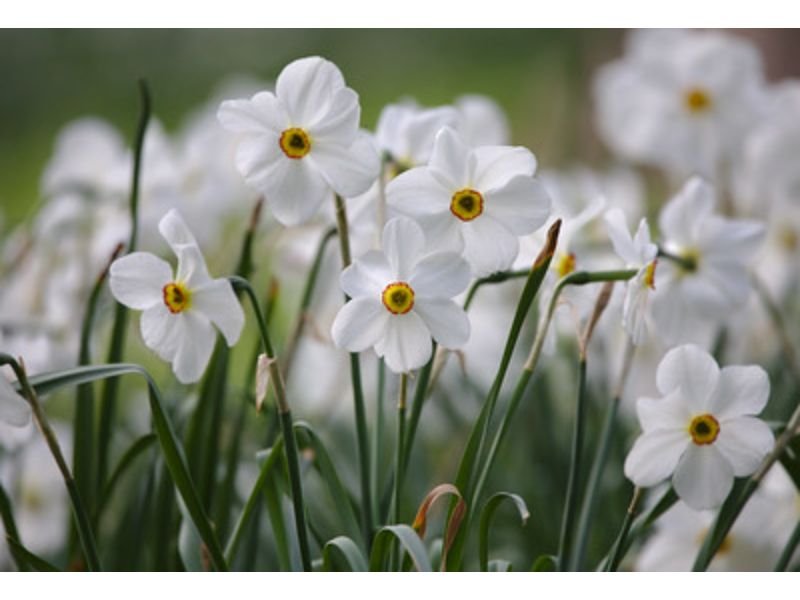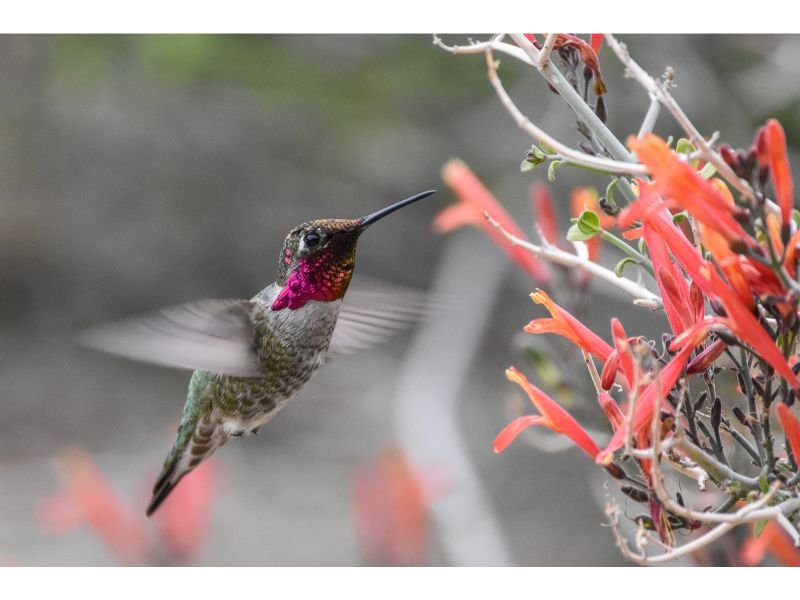Last updated on June 9th, 2023 at 06:44 am
Growing hydrangeas and roses side by side can create a stunning and harmonious display in your garden. While these two plants have different growth habits and requirements, with some careful planning and maintenance, you can create a beautiful garden that showcases both of these beloved plants. In this article, we will provide you with expert tips and techniques on how to grow hydrangeas with roses that will help you create an impressive garden that will stand out from the crowd.
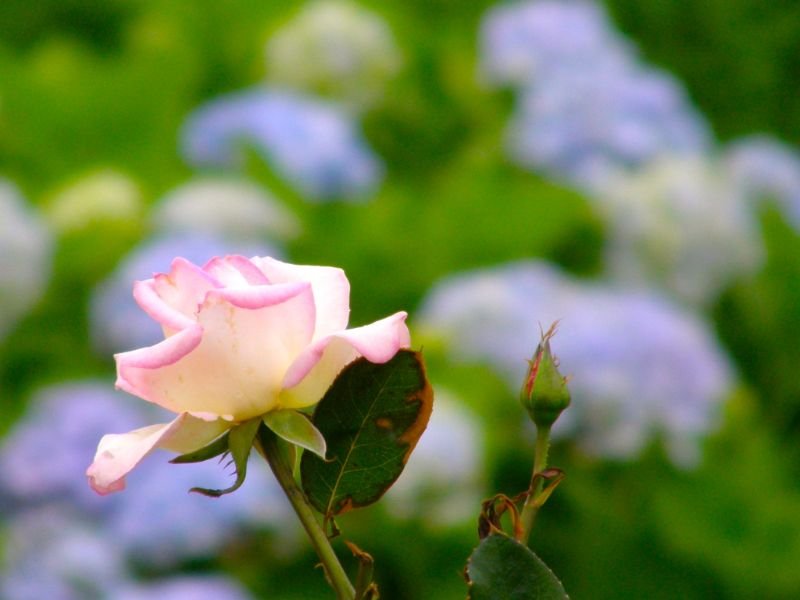
Table of Contents
Hydrangeas and Roses growing stages
| Hydrangeas growing stages | Timeframe | Description |
|---|---|---|
| Seed Planting | Early spring or fall | Hydrangea seeds are planted in a seed tray or pot with well-drained soil. |
| Germination | 2-3 weeks | Seeds begin to sprout and develop into seedlings. |
| Seedling Growth | 4-6 weeks | Seedlings establish their root system and develop their first true leaves. |
| Transplanting | Late spring or early summer | Seedlings are transplanted into individual pots or the garden bed. |
| Vegetative Growth | Spring and summer | Hydrangeas focus on leaf and stem development, growing rapidly. |
| Flower Bud Formation | Late summer to early fall | Buds start forming at the tips of the branches for the next year’s blooms. |
| Winter Dormancy | Late fall to early spring | Hydrangeas go into a dormant phase, losing their leaves. |
| Spring Growth Resumes | Early spring | New growth emerges from the dormant branches, including leaves and flower buds. |
| Blooming | Spring and summer | Hydrangeas produce their iconic blooms, displaying various colors depending on the variety. |
| Roses growing stages | Timeframes | Description |
|---|---|---|
| Seed Planting | Early spring or fall | Rose seeds are planted in a seed tray or pot with well-drained soil. |
| Germination | 2-3 weeks | Seeds begin to sprout and develop into seedlings. |
| Seedling Growth | 4-6 weeks | Seedlings establish their root system and develop their first true leaves. |
| Transplanting | Late spring or early summer | Seedlings are transplanted into individual pots or the garden bed. |
| Vegetative Growth | Spring and summer | Roses focus on leaf and stem development, growing rapidly. |
| Flower Bud Formation | Late summer to early fall | Buds start forming at the tips of the branches for the next year’s blooms. |
| Winter Dormancy | Late fall to early spring | Roses go into a dormant phase, losing their leaves. |
| Spring Growth Resumes | Early spring | New growth emerges from the dormant branches, including leaves and flower buds. |
| Blooming | Spring and summer | Roses produce their characteristic flowers, showcasing a variety of colors and fragrances. |
| Maturity | 2-3 years | Roses reach their full size and blooming potential. |
Benefits of growing hydrangeas and roses together
Growing hydrangeas and roses together is not only visually stunning but also offers a multitude of benefits for your garden.
The combination of these two plants creates a captivating display of colors, shapes, and fragrances that instantly elevate the beauty of any outdoor space. The lush and abundant blooms of hydrangeas perfectly complement the elegance and charm of roses, resulting in a harmonious blend that captivates the eye and evokes a sense of serenity.
Moreover, the coexistence of hydrangeas and roses enhances the overall health of the garden by attracting pollinators and beneficial insects, creating a thriving ecosystem.
With their contrasting yet complementary characteristics, growing hydrangeas and roses together allows you to experience the best of both worlds and create a truly remarkable and enchanting garden.
Choosing the Right Varieties
When it comes to choosing the right varieties of hydrangeas and roses, there are a few things to consider.
First and foremost, it’s important to select varieties that will complement each other in terms of size and growth habits. This means choosing hydrangeas that won’t overshadow your roses or take up too much space in your garden.
One option is to look for more compact varieties of hydrangeas, such as the dwarf hydrangea or the ‘Cityline’ series. These varieties have a moderate growth habit and won’t grow too large or tall, making them a great choice for smaller gardens or planting beds. In addition, these compact hydrangeas tend to have smaller blooms, which can help balance out the larger flowers of many rose varieties.
When it comes to roses, choose those that have a more upright habit and are not as sprawling. Roses with a compact growth habit, such as floribundas or grandifloras, are an excellent choice for pairing with hydrangeas. These roses will complement the hydrangeas’ rounded shape while adding height and texture to the garden.
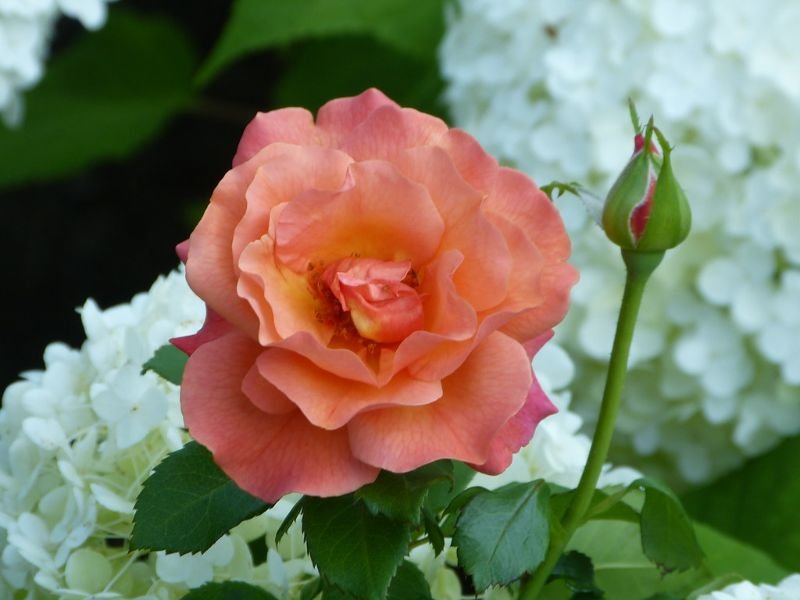
Another factor to consider when choosing hydrangeas to plant with roses is the color of the blooms. While there are many different colors of hydrangeas to choose from, some shades may complement your roses better than others. For example, if you have red or pink roses, you may want to look for hydrangeas in shades of blue or purple to create a pleasing contrast.
Overall, choosing the right varieties of hydrangeas and roses is essential for creating a harmonious and balanced garden. By selecting compact hydrangeas with moderate growth habits and complementary bloom colors, you can ensure that your garden is a stunning showcase of these beautiful plants.
Planting and Placement
When it comes to planting, hydrangeas and roses have different requirements. Hydrangeas prefer soil that is well-drained but also retains moisture, while roses thrive in soil that is more fertile and well-drained. Therefore, it is essential to choose a planting site that provides these conditions for both plants.
When planting hydrangeas and roses, make sure to space them adequately. Hydrangeas should be planted at least 3 to 4 feet apart to allow them enough room to grow and spread. Roses, on the other hand, should be planted at least 2 to 3 feet apart to allow air circulation and prevent the spread of diseases.
Maintenance and Care
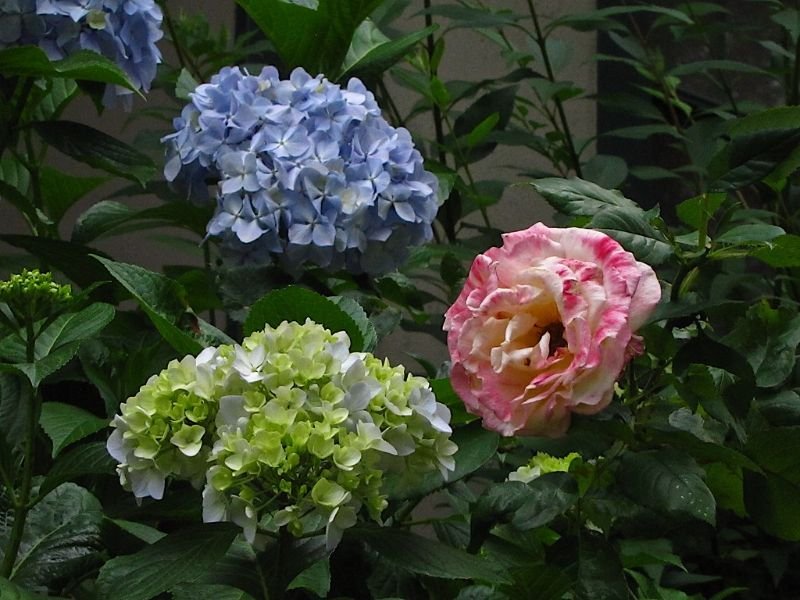
To ensure that your hydrangeas and roses thrive and grow healthy, you must provide them with the proper maintenance and care. Here are some tips to help you care for your plants:
Watering
Hydrangeas and roses both require regular watering to thrive. Hydrangeas need deep watering once a week, while roses require more frequent watering to keep the soil moist but not waterlogged.
Fertilizing
Hydrangeas and roses both benefit from regular fertilization. For hydrangeas, use a fertilizer that is high in phosphorus to promote blooming. For roses, use a balanced fertilizer that is rich in nitrogen to promote healthy growth.
Pruning
Regular pruning is essential for both hydrangeas and roses to promote healthy growth and flowering. Hydrangeas should be pruned in late winter or early spring, while roses should be pruned in late winter or early spring and again in mid-summer.
Pest and Disease Control
Both hydrangeas and roses are susceptible to pests and diseases, so it is essential to monitor them regularly and take action immediately if you notice any signs of infestation or disease. Using organic pest and disease control methods can help protect your plants without harming beneficial insects.
Creating a Stunning Garden
By following these expert tips and techniques on how to grow hydrangeas with roses, you can create a stunning and harmonious garden that will impress everyone who sees it. With some careful planning and maintenance, you can enjoy a beautiful garden that showcases the best of both of these beloved plants.
FAQs
Can hydrangeas and roses be planted in the same garden?
Yes, hydrangeas and roses can be planted in the same garden. In fact, their combination can create a visually stunning display and enhance the overall beauty of your outdoor space.
Do hydrangeas and roses require the same care and maintenance?
While hydrangeas and roses have some similarities in care, they do have different requirements. Hydrangeas prefer well-drained soil with moisture retention, while roses thrive in fertile, well-drained soil. Both plants require regular watering and fertilization, as well as pruning for healthy growth and blooming.
Can I plant different varieties of hydrangeas and roses together?
Yes, you can plant different varieties of hydrangeas and roses together. When selecting varieties, consider their size, growth habits, and bloom colors to ensure a harmonious combination. Compact hydrangeas and roses with upright growth habits are generally a good choice.
Are there any benefits to growing hydrangeas and roses together?
Yes, there are several benefits to growing hydrangeas and roses together. The combination attracts pollinators and beneficial insects, promoting a thriving garden ecosystem. Additionally, the visual contrast and complementary characteristics of these plants create a captivating and serene garden ambiance.
Can I grow hydrangeas and roses together in containers or small spaces?
Yes, it is possible to grow hydrangeas and roses together in containers or small spaces. Opt for compact varieties of hydrangeas and roses, and ensure proper spacing between plants. Provide adequate watering, fertilization, and pruning to accommodate their growth requirements. With careful planning and maintenance, you can create a beautiful display even in limited spaces.

Gardening is my passion and growing plants indoors has always been a stress relief for me. Grow a banana tree in my apartment once (although failed to produce bananas).

